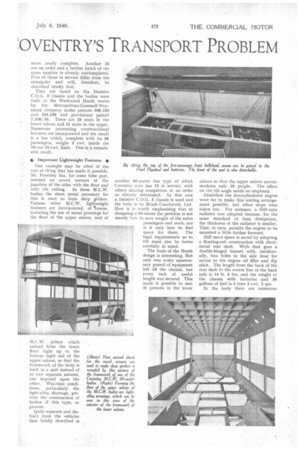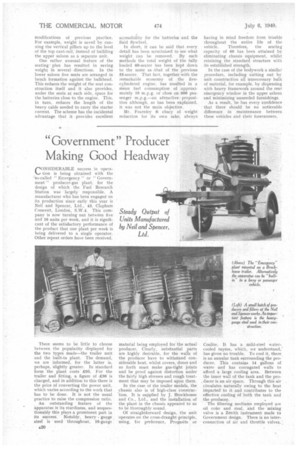FOUR-WHEELED 60-SEATERS SOLV
Page 20

Page 21

Page 22

If you've noticed an error in this article please click here to report it so we can fix it.
10VENTRY'S TRANSPORT PROBLEM Modern Body Construction Permits Substantial Increase in Carrying Capacity Without Materially Affecting Size, Weight or Durability CRAMMING a quart into a pint pot is a feat which even modern science has not yet managed, but something resembling it has been successfully contrived by Coventry Corporation transport department in conjunction with the Daimler Co., Ltd„ and two bodybuilding companies. The achievement is that of providing adequate accommodation for 60 passengers in a bus neither larger nor heavier than those which previously have never seated more than 56 persons.
We made reference some months ago to this specific matter, but since then there have been further developments which give it a new interest, When Mr. Ronald A. Fearnley, M.I.A.E., M,Inst.T., general manager and engineer of the department, investigated the possibilities in this direction, he had in mind much more than the mere carrying of extra passengers without additional cost. That, no doubt, was an attraction, but Mr. Fearnley has always followed a policy of providing the passenger with something more than a square deal, and no change towards greater seating capacity_ was likely to be favoured by him unless it carried advantages for the public as well as for the operator.
Fortunately, in this matter, the two interests coincided. Although not unique, conditions in Coventry show in an extreme form certain difficulties which are to be found elsewhere. That city is old and, despite recent recon struct ion on a fairly grand scale, its centre is still a network of narrow streets. On the other hand, Coventry is modern, in that it is the site of numerous factories including several large ones. Thus, heavy peak traffic has to be handled in streets evolved for the limited and leisurely movements of medieval times.
In such circumstances, the problem cannot be solved by a mere multiplication of vehicles, for the streets Will not carry them. The answer, in short, is that each bus must carry more people. Only thus can the public be taken home from work without delay.
• Benefits of Large Capacity •
Compare, for example, these new buses with the old 48-seaters. On a five-minute service the difference is equivalent to three buses an hour—an extra 144 people. Even in the case of the 56-seaters it is clear that 16 of them would be needed to carry a crowd which could ride in 15 of the latestCoventry buses.
Here it may be recalled that 60-seaters are not entirely, new to Coventry. Earlier examples, however, were six-wheele:s and it . was found that this type is not well suited to local conditions. Normal Daimler four-wheeled chassis are used in the new buses which have the distinction,' also, of being the first metal-framed 60-seaters of this type in regular service in this country.
Two types are in use now, the total number at present being 15 with 10
more nearly complete. Another 25 are on order and a further batch of the same number is already contemplated. Five of those in service differ from the remainder and will, therefore, be described briefly first.
They are based on the Daimler C.O.A. 6 chassis and the bodies were built at the Washwood Heath works by the Metropolitan-Cammell-Weymann company under patents 336,103 and 355,536 and provisional patent 7,338/39. There are 29 seats in the lower saloon and 31 seats in the upper. Numerous interesting constructional features are incorporated and the result is a bus which, complete with its 60 passengers, weighs 3 cwt. inside she 10-ton 10-cwt. limit. This is a remarkable result.
• Important Lightweight Features •
One example may be cited of the sort of thing that has made it possible. Mr. Fearnley has, for some time past, insisted on coved corners at the junction of the sides with the floor and with the ceiling. In these M.C.W. bodies the sheet metal necessary for this is used to form deep girders. Various other M.C.W. lightweight features are incorporated, of °course, including the use of metal pressings for the floor of the upper saloon, and of
M.C.W. pillars which extend from the lower floor right up to the bottom light rail of the upper saloon, so that the framework of the bbdy is built in a unit instead of as two separate saloons, one imposed upon the other. War-time conditions, particularly the light-alloy shortage, prevent the construction of bodies dl this type, at present.
Quite separate and distinct from the vehicles thus briefly described is
another 60-seater bus type of which Coventry now has 10 in service, with others nearing completion or on order as already mentioned. In this case a Daimler C.O.G. 5 chassis is used and the body is by Brush Coachwork, Ltd. Here it is worth emphasising that in designing a 60-seater the problem is not merely how to save weight of the extra passengers and seats, nor is it only how to find space for them. The legal requirements as to tilt must also be borne carefully in mind.
The basis of the Brush design is interesting. Not only was every unnecessary pound of equipment left off the chassis, but every inch of useful length was secured. This made it possible to seat 31 persons in the lower saloon so that the upper saloon accommodates only 29 people. The effect on the tilt angle needs no emphasis.
Doubtless the five-cylindered engine went far to make this seating arrangement possible, but other steps were taken too. For instance, a Still-tube radiator was adopted because, for the same standard of heat dissipation, the thickness of the radiator is smaller. That, in turn, permits the engine to be mounted a little farther forward.
Still more space is saved by adopting a floating-cab construction with sheetmetal rear dash. With that goes a double-hinged bonnet with, incidentally, two holes in the side door for access to the engine oil filler and dip stick. The length from the back of the rear dash to the centre line of the back axle is 14 ft. 5 ins, and the weight of the chassis with batteries and 30 gallons of fuel is 4 tons 2 cwt. 2 qrs.
In the body there are numerous modifications of previous practice. For example, weight is saved by running the vertical pillars up to the level of the top cant-rail, instead of building the upper saloon as a separate unit.
One rather unusual feature of the seating plan has resulted in saving weight in severaldirections. In the lower saloon five seats are arranged in bench formation against the bulkhead. This reduces the weight of the seat construction itself and it also provides, under the seats at each side, space for the batteries close to the engine. This, in turn, reduces the length of the heavy cable needed to carry the starter current. The scheme has the incidental advantage that it provides excellent accessibility for the batteries and the fluid flywheel.
In short, it can be said that every detail has been scrutinized to see what weight can be removed. By such methods the total weight of the fully loaded 60-seater has been kept down to the same as .that of the previous 55-seater. That fact, together with the remarkable economy of the fivecylindered engine, has resulted in a mean fuel consumption of approximately 10 m.p.g. or close on 600 passenger m.p.g.—an attractive proposition although, as has been explained, it was not the main objective.
Mr. Fearnley it chary of weight reduction for its own sake, always having in mind freedom from trim* throughout the entire life of the vehicle. Therefore, the seating capacity of 60 has been attained by eliminating chassis equipment, whilst retaining the standard structure with its established strength.
In the case of the bodywork a similar procedure, including cutting out by unit construction all unnecessary bulk of material, for example, by dispensing with heavy framework around the rear emergency window in the upper saloon and minimizing unneeded furnishings.
As a result, he has every confidence that there should be no noticeable difference in maintenance between these vehicles and their forerunners.




















































